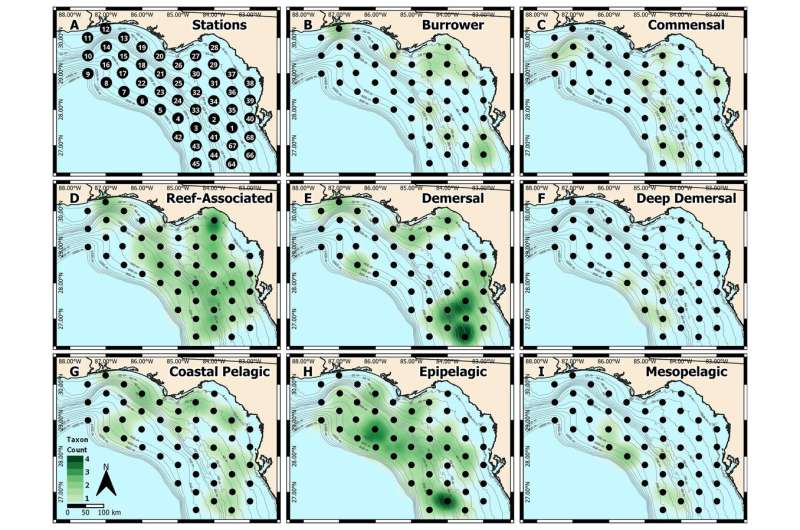This article has been reviewed according to Science X's editorial process and policies. Editors have highlighted the following attributes while ensuring the content's credibility:
fact-checked
peer-reviewed publication
trusted source
proofread
Evaluation of DNA metabarcoding for identifying fish eggs: A case study on the West Florida Shelf

A new study published in PeerJ and featured in the International Association for Biological Oceanography Hub evaluates the use of DNA metabarcoding to identify fish eggs. The study assessed the performance of DNA metabarcoding to increase throughput and reduce financial and labor costs associated with a long-term fish egg monitoring program.
The study found:
- Egg identifications were consistent with prior species distributions observed from individual egg DNA barcoding, and spatial heatmaps of eggs corresponded to known habitat types occupied by adults.
- Increased throughput allowed by metabarcoding resulted in the identification of taxa not previously detected in this region, possibly representing episodic spawning events.
- Metabarcoding can expand the number or geographic range of samples that can be processed.
- One disadvantage of metabarcoding is that the method is not quantitative and requires the application of a threshold proportion of sequences required to count a taxon as present.
The study highlights the importance of establishing long-term fish egg monitoring, as it is critical for protecting spawning sites and habitats used by fishes during their early life stages. Identifying fish egg composition over long time scales and at high spatial resolution is extremely valuable for observing changes in spawning dynamics of different fishes and deciphering how human activities affect fish spawning.
DNA metabarcoding involves amplification and sequencing of a conserved gene that is present in all animals, allowing identification of the organism upon comparison to a database. In the case of this study, fish eggs were collected by towing a plankton net which collects free-floating eggs—since the majority of fish are broadcast spawners, meaning they release their eggs into the water column. The research team then processed all the fish eggs together as a composite, significantly reducing the cost of the process.
"It is always interesting to see where we detect eggs from different fish species. In this paper, we recovered eggs from three fish species we hadn't previously documented spawning for in this area: Atlantic blue marlin, crested scabbardfish, and burrfish. However, I think the most interesting (and frustrating) finding from this research was that sometimes we recovered more species from a given sample than the number of eggs in that sample, which indicates contaminating DNA.
"The source of this DNA is most likely environmental DNA which is shed by all living species and can get stuck to the outside of the fish eggs. We had to apply a threshold (i.e., a cut-off for the proportion of sequences belonging to a particular species) to consider that species as present—and this likely introduces biases by excluding rare species," said Professor Mya Breitbart, from the College of Marine Science at the University of South Florida.
While DNA metabarcoding was not advantageous for the team's long-term study's goals, the researchers report many potential applications of the technique for fish egg identification. For example, researchers could combine all the eggs collected in a geographic region in a given season and use metabarcoding to generate an overview of fish spawning at that time, which can then be compared to other seasons.
More information: Mya Breitbart et al, Evaluation of DNA metabarcoding for identifying fish eggs: a case study on the West Florida Shelf, PeerJ (2023). DOI: 10.7717/peerj.15016
Journal information: PeerJ
Provided by PeerJ





















